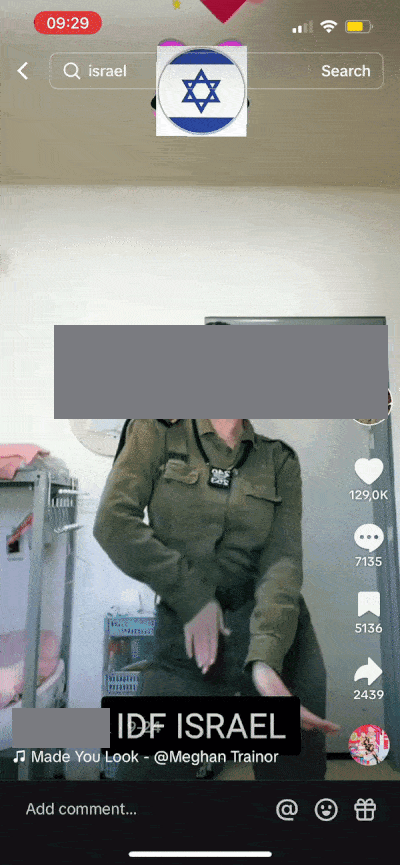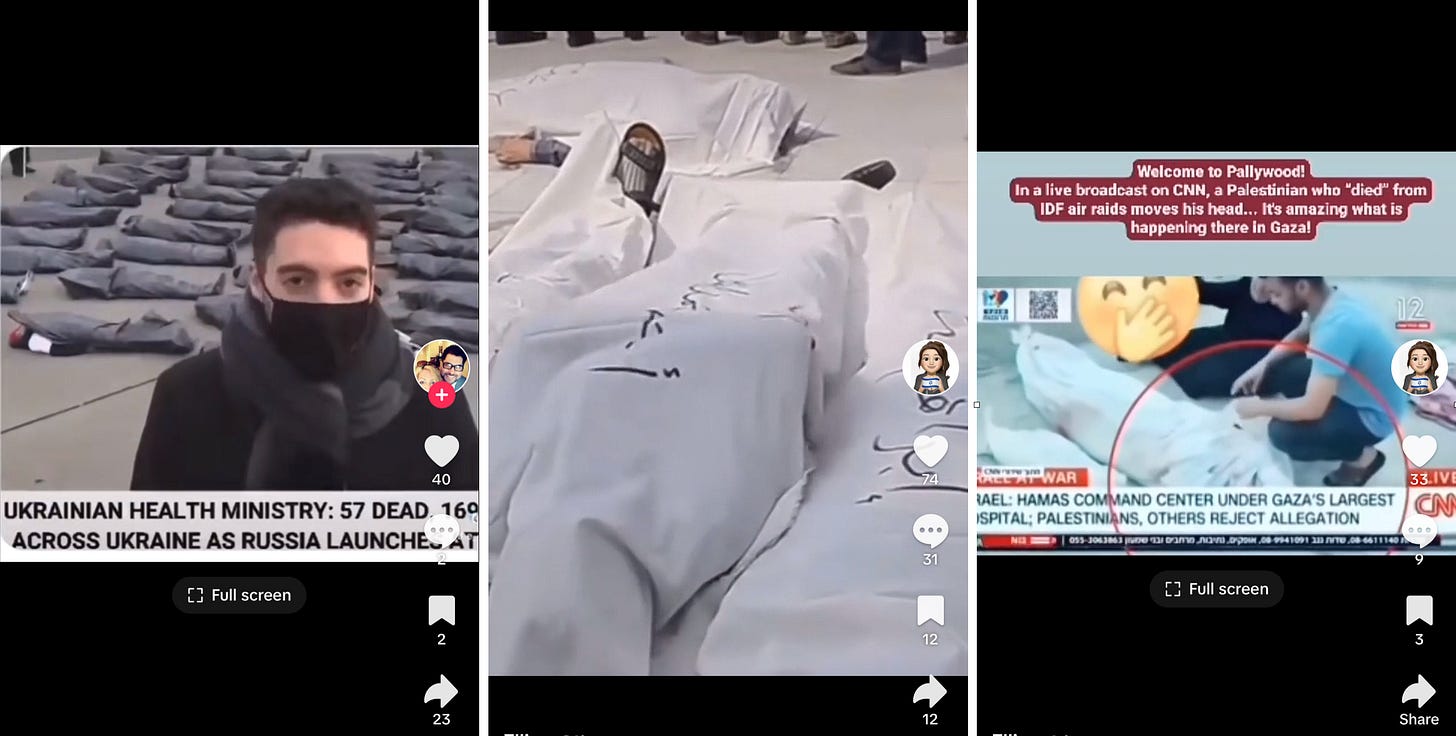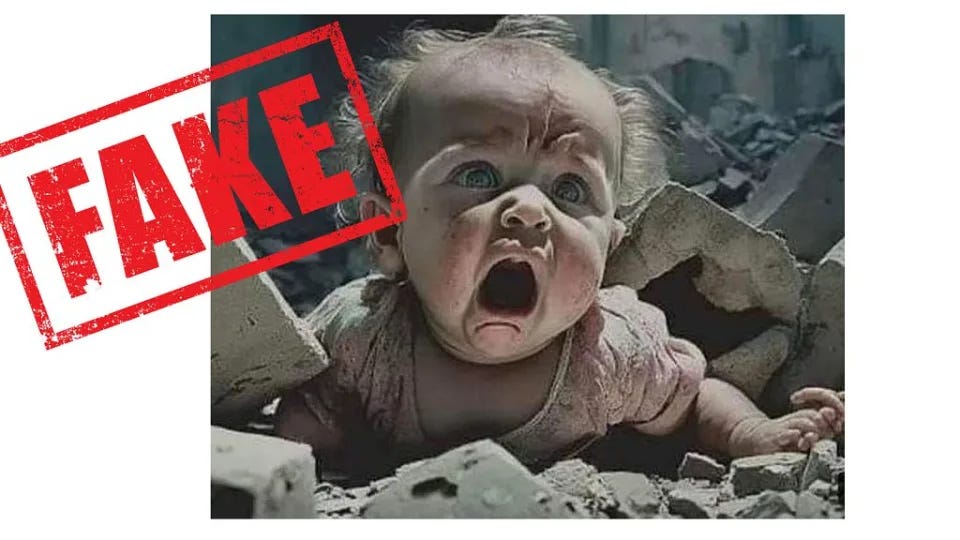Hello,
you are reading Understanding TikTok. My name is Marcus. I am an internet researcher at HAW Hamburg, investigating TikTok and propaganda. This week i gather observations concerning the ongoing 2023 Israel–Hamas war and try to contextualize them in the short history of TikTok in conflicts and war.
Information Pollution
A widely-shared thread on X has claimed that TikTok is serving overwhelmingly pro-Palestine videos to young people with Israel “losing the information war”. I am highly sceptical when venture capitalist crypto bros try to reverse engineer the TikTok algorithm on the weekend “researching” by “looking at data” with a clear goal: TikTok poses a threat to U.S. national security by spreading false information.
This – of course – happens on all platforms available. The chief executives of Meta, TikTok, X and Google each received letters from EU commissioner Thierry Breton earlier in October who formally asked to provide the EU with information about the possible spread of disinformation on their platforms relating to the Israel-Gaza conflict (BBC).
What we are seeing here is part of a fundamentally and irreversibly altered information landscape that started to already emerge in the 1960s due to read/write media. More people could now create and distribute media content from their basement or office leading to a rise in polluted information (Phillips, W., & Milner, R. M. (2021). You are here: A field guide for navigating polarized speech, conspiracy theories, and our polluted media landscape. MIT Press).
And polluted information is what we see on our For You Pages right now: news reports next to decontexualized disinformation, next to hand-made cheap fakes, next to highly emotional personal statements, kids, animals, next to explainers by who knows who. Let’s stick to independent researchers with ethical guidelines and transparent processes like the Institute for Strategic Dialogue (ISD). Here you can find: Violent and graphic content of the Gaza conflict served to minors’ accounts (October 18) Russia, China and Iran use X to exploit Israel-Hamas information chaos (October 25).
Memetic Warfare
In addition to an already polluted information environment propaganda has never been more abundant and difficult to identify due to the decentralized and rhizomatic nature of digital spaces and memetic warfare, writes Idil Galip (Propaganda, Digital Diplomacy, Meme Wars: How Digital Confrontation Is Shaping the New World Order. in “Multipolarity After Ukraine: Old Wine in New Bottles?”. 2023. Italian Institute for International Political Studies. Print and Online. 2023.) Memetic warfare is understood as “digital propaganda, a warlike practice of competing over narratives, ideas and social control with memes as its main currency”.
These memetic strategies to compete over narratives obey platform logics and mimic strategies that have been applied in WarTok I. The Russia–Ukraine War is of course not the first to be extensively covered on social media and especially TikTok, but singular in scale and impact. I will be comparing strategies and images next.
Dancing Soldiers
Dancing Ukrainian soldiers like user Alex Hook got a lot of views, likes, interaction and global media coverage in March 2022 (#73). Accumulating 88 million views within 24 hours, this video gained significant attention due to the intriguing sight of a soldier’s playful performance that challenged the typical image of a combat zone. Hook’s profile garnered approximately 1 billion views by March 24, his distinguished dancing style sparked a dance challenge on TikTok featured with the #AlexHook hashtag (476 million views).
As Tom Divon and i argue Hook’s videos, however, also have the potential to mislead viewers as they convey, via whimsical songs, expressive body performance, and captions, “a misleading narrative for the users, who will only see a certain part of the story” (Woolley & Howard, 2019, p. 54) both platform users and an international audience are exposed to propaganda messages intended to sway public opinion in favor of Ukraine.
Way before the current events Israeli soldiers could already be seen dancing e.g. on the Official TikTok of the Israel Defense Forces: Dance like nobody’s watching 💃#InternationalDanceDay#IDF#Freestyle#Dance in April 2021, on countless private accounts amongst other things copying Ukrainian propaganda dance challenges e.g. 🥀 The boy with the red poppy (#106). Since the Hamas terror attacks on October 7 i have seen an increase of mainly female soldiers gearing up for battle (“Beautiful Warriors on Fire”) utilizing current trending TikTok sounds and beauty filters (e.g. Coral). Together with e.g. this official IDF video (This is what we’re fighting for 🇮🇱 // #standwithisrael #israelunderattack #israel #idf Counter Speech) showing “good-looking, friendly, confident” male soldiers they serve a clear goal: To humanize
soldiers and to compete over narratives applying well-learned lessons of (political) authenticity and supposed realness. In the background of course are separate departments in the ministry for digital combat operations, such as the creation of Tiktok videos, which develop guidelines and workshops for soldiers as German political advisor Martin Fuchs points out (Watson).
Livestreams
From the early days of the war, fake livestreams have drawn some of the highest numbers of views on TikTok, wrote the BBC back in April 2022 and quoted independent researcher Abbie Richards: "It seems like a lot of the looped scary livestreams were likely created with the hopes of earning money via TikTok's gifting system." TikTok users can react to livestreams by sending the accounts points that can be converted into cash. While bad actors misused pre-recorded, stolen or looping videos during the war in Ukraine (e.g. while hiding in the subway station) to make money, the livestreaming landscape on TikTok has changed and users have adopted.
In the days after Hamas attacked Israel on October 7, TikTok creators have been engaging in “live matches” on the platform (as yet again observed by Richards) where one creator plays the role of Israelis and the other that of Palestinians, while encouraging—and often shouting at—their followers to continue to donate expensive gifts. The side with the most gifts after five minutes wins the battle (Wired). Interesting side fact: The full value of the gift is not transferred to the creator, with TikTok taking a significant slice of each gift donated.
Moving Body Bags
TikTok has been flooded yet again with an endless amount of misleading videos. According to the General Manager TikTok Deutschland Tobias Henning in a recent interview (WiWo) “97 percent of content is taken down before it is seen” but if you scroll through the search results #Israel #Palestine it only takes you a minute or two before you encounter very obvious, slightly obvious and not so obvious misleading information. A recurring strategy that has both occurred in Ukraine and now is the claim that one conflict party is faking evidence by filming allegedly dead people that then start moving in their body bags.
Tom Divon and i have identified pro-Russian propaganda attempts to spread disinformation via manipulated content showing 57 body bags of alleged Ukrainian casualties on the first day of the invasion, with one person shown moving and struggling to get out. However, the original video material shows Austrian climate protesters demonstrating in Vienna in early 2022, as documented by fact-checkers on Twitter (@Seana_Davis, 2022).
In 2023 footage of “bodies” in shrouds shows Egyptian protesters in 2013, not faked deaths of Palestinians in Gaza as AFP has found out.
Deep/cheap-fakes, AI and synthetic media
Despite a deep fake video of Zelensky synthetic media has not yet played a decisive role in Russia/Ukraine. According to Layla Mashkoor, an associate editor at the Atlantic Council’s Digital Forensic Research Lab quoted in this Wired article : “There are definitely AI images circulating {concerning Israel/Hamas} but not to the degree where I think it’s playing a central role in the spread of information”. AI {concerning Israel/Hamas} is currently being used by activists to solicit support—or give the impression of wider support—for a particular side. Examples include an AI-generated billboard in Tel Aviv championing Israel Defense Forces, an Israeli account sharing fake images of people cheering for the IDF, an Israeli influencer using AI to generate condemnations of Hamas, and AI images portraying victims of Israel’s bombardment of Gaza.
WarTok I vs. II
A lot of observations when comparing the usage of TikTok at the beginning of 2022 (Russia/Ukraine) and the end of 2023 (Israel/Hamas) are similar: A polluted information landscape infused by memetic warfare. While there are similar propaganda techniques to “own the narrative” (Dancing soldiers) or strategies to benefit from a conflict (Livestreaming) there are clear differences in both wars on TikTok as well.
This time state actors are involved more directly on TikTok with Israel (477.7K Followers 4.9M Likes), IDF (englisch account (284K Followers 4.7M Likes), hebrew account (307 K Followers 9.3M Likes)) and the Prime Minister of Israel (522.8K Followers 4.5M Likes) having their own accounts. The latter has not yet posted since October 6. Hamas has been banned from TikTok (New York Times) but videos posted on Telegram channels find their way on the platform too. Here is a more general take on the Hamas Propaganda War (New Yorker).
While war influencers shaped parts of the war discourse around Ukraine giving insights and delivering unseen eye witness reports in TikTok-style (Bomb Shelter Vibes) until now i could not observe anything similar in the Israel/Hamas-conflict. This might be due to temporarily cut off internet connections in Gaza or more so due to self-protection with TikTok users being more and more aware of the costs of exposing oneself online in a war or a developing strategies on the platform. Compare this Vice report from 2021: Palestinian TikTok Memes Show How They Feel About Israeli Occupation
On a more personal note the research on both wars in the context of participatory propaganda where participants often do not realize they are involved in amplifying propaganda messages has led me to be more careful in the way i want to inform, especially after having read the article Don’t Contribute to this Media War by Marloes Geboers and Esther Hammelburg
That was a monothematic edition. I’ll be back soon with TikTok Tools and more. Thanks for reading. Ciao.










